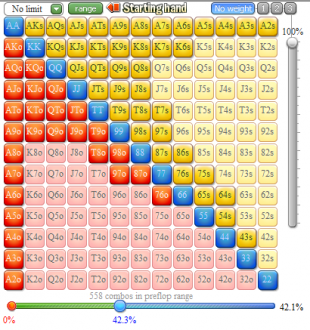Range protection and balance in poker are very important for making our plays harder to read and much more difficult for our opponents to exploit our tendencies.
Balance and Range Protection
Balance. It's a concept we hear

discussed frequently by coaches and good players, but how important is it really? We've probably heard from other good players and coaches that balance is a complete waste of time, and all we really care about is exploiting our opponents. So which viewpoint is correct?
Balance in Poker and Partial Balance
One issue is that players sometimes mean different things when they talk about balance. Players are not always referring to true theoretical optimal balance. Sometimes they may be referring to more partial type of balance.
For example, imagine every single time we fire 3 barrels we show up with a strong value hand. That's something that our opponents might pick up on very frequently. We could be exploited for this. So is the solution to revert to a
GTO strategy where we bluff the river 33% of the time or so? Not necessarily. In fact, even if we just bluff very occasionally in this spot we make ourself significantly tougher to play against.
It's easy to identify when someone shows up with a value-hand with 100% frequency. Add one or two bluffs and it's much harder for our opponent to get a read. They might mistakenly assume that we are changing our strategy and are now actually bluff-heavy.
Imagine every single time we fire 3 barrels we show up with a strong value hand. That's something that our opponents might pick up on very frequently.
Even if they don't make this assumption they now need a considerably bigger sample to work out our exact frequencies. That small measure of balance is enough to throw a spanner into the works of what would otherwise be an easy decision for our opponent.
Range Protection in Poker
Range protection really involves the even distribution of different holdings across our overall strategy and the various lines we take. If some of the lines we take do not contain enough value hands, then we are exposing a hole in our game which our opponents can exploit.
For example, imagine a spot where we open-raise in the SB and the BB decides to call. Many players may show a strong tendency to cbet all of their nutted hands, especially if the board texture is drawy. This means our cbetting range is well protected. However what about our checking range?
Naturally if we've used all of our strong hands in
our c-betting range, we have none left over to use for our checking range. We need to distribute our monsters across the different lines we take. If we ever take a line which doesn't contain any value hands (simply checking as PFR in this case), then we become vulnerable to exploits. Our opponent can simply bet any 2 cards vs our unprotected range.
The same might happen IP to an extent. Perhaps we have a tendency to cbet all of our strong hands in position and never check back. An astute opponent can lead the turn recklessly against us, knowing that our range is essentially unprotected. It's slightly less problematic IP since that turn card may improve some of our range even if we check back the flop with primarily weak holdings. OOP if we have an unprotected checking range we won't even get to see a turn card most of the time.
An astute opponent can lead the turn recklessly against us, knowing that our range is essentially unprotected.
Air is important for balance in poker, too!
This is a commonly

misunderstood concept. Many players simply believe range-protection is about having enough strong hands in our range so that our opponents cannot bluff recklessly. Having a range which is too strong can also be considered and unprotected range however. Pretty much all ranges need some nutted hands and some air type hands.
The only hands which are not a vital necessity to a balanced range are the mid-strength hands. But naturally we want to play these, and assuming we do play them we need to protect them with some nuts and some air.
So how exactly do we protect our range with air? Wouldn't we prefer to not have any air?
Let's imagine we
3-bet SB vs BTN and the flop comes
K72.
Which type of hands should we be protecting our x/c range with. We mentioned earlier that it is not correct to cbet all of our strong holdings.
Most of us probably realise it is a good idea to x/c hands like TT-QQ or weak Kx. Maybe some of us would even protect these mid-strength hands with some monsters like KK/AK/AA.
Unfortunately for the majority of us, this is as far as it goes. But why is this a problem? True, we have some medium hands but they are well protected by our slowplays, so what's the big deal?
So imagine, we x/c the flop with some Kx and TT-QQ. Turn is a blank 2 and goes check/check. River is a blank 5. How should we play on the river in this situation?
Doubtless we should lead our nutted hands for value. In fact, we should even potentially value-bet QQ-TT on this runout. Assuming we felt value-betting was not profitable then we would put QQ-TT in either our check/call bluffcatch range or our check/fold range. Returning to our earlier concept of balance however – we are aware that we can't always be
value-betting in a certain situation.
We need to balance out this river line with some bluffs. So which bluffs should we choose? Hold on....do we even have any bluffs? We've put ourself in that situation were every single time we bet the river it is for value. This is super easy to exploit. Our opponent can pretty much safely fold anything that is not a premium, and we are getting exploited hard.
Returning to our earlier concept of balance however – we are aware that we can't always be value-betting in a certain situation.
This is clearly not a mistake with our river strategy. It's not our fault that we don't have any good hands to use as bluffs. Or is it? Let's think back to the flop situation. How can we redesign our flop strategy so that we have some decent hands to use as river bluffs?
It means we are going to need to start check/calling some air hands on the flop. Ideally those with some good backdoor potential. We should obviously use these in our cbetting range also – in fact decent back-door hands are primarily cbets. But if we don't check/call them with some frequency our river leading range becomes super unbalanced.
And not just our river lead frequency – pretty much any other line in the hand we might take – whether it be check-raising the turn or even donk-betting is going to be unbalanced towards value.
This is something that is still common misunderstood by the vast majority of players. If we ask them what the necessary criteria to check/call a hand as the PFR is, they'll generally tell us that we should have some type of showdown value. They would likely dismiss the idea of check/calling some type of speculative hand as horrible – the showdown value is too low. But we saw the huge issue with the hand in the river situation was that we had too much showdown value!
Let's think back to the flop situation. How can we redesign our flop strategy so that we have some decent hands to use as river bluffs?
Balance in Poker: Equal Distribution of Air
Seeing as we

have relatively few strong made hands, and large amount of air hands in general (most times we miss the flop), our goal should be to distribute our air hands evenly across the different lines we take.
If we use too much of our air in one particular line we create a vulnerability in our game, where that particular line simply does not have enough strong hands to protect the large amount of air hands.
Imagine a situation where we call a 3-bet preflop and then call a cbet on a
J107 board. The turn card is a
blank 3 and our opponent checks to us. Stats analysis would generally indicate that we can profitably bet any 2 cards vs most opponents after he misses his turn cbet. It's theoretically correct however to check back some of our air hands until the river. Firing all of our air hands on the turn would create an uneven distribution.
This is a problem for 2 reasons.
- it makes us vulnerable to turn check/raises since we have so many air hands
- if we fire all of our air on the turn and check back mid-showdown holdings we have no decent hands to use as bluffs on the river.
In other words our turn betting range is air heavy, while our turn check back range is mid-showdown heavy. Ideally we check back a decent chunk of our air to balance our river betting range and also to ensure our turning betting range is not vulnerable to turn check-raises.
It's important to understand that we are not necessarily saying a strategy where we bet 100% of our air hands on the turn shouldn't be used in practice. It's a great exploitative strategy in some instances. But we can say for certain that it's an unbalanced strategy and can be exploited by a good opponent.
Balance and range protection in poker can be a complex topic, but remember our goal is not necessarily perfect game theory optimal balance. No-one even fully understands what that looks like at this stage. However, even bringing a partial amount of balance to our game can make us significantly tougher to play against.
 discussed frequently by coaches and good players, but how important is it really? We've probably heard from other good players and coaches that balance is a complete waste of time, and all we really care about is exploiting our opponents. So which viewpoint is correct?
discussed frequently by coaches and good players, but how important is it really? We've probably heard from other good players and coaches that balance is a complete waste of time, and all we really care about is exploiting our opponents. So which viewpoint is correct? misunderstood concept. Many players simply believe range-protection is about having enough strong hands in our range so that our opponents cannot bluff recklessly. Having a range which is too strong can also be considered and unprotected range however. Pretty much all ranges need some nutted hands and some air type hands.
misunderstood concept. Many players simply believe range-protection is about having enough strong hands in our range so that our opponents cannot bluff recklessly. Having a range which is too strong can also be considered and unprotected range however. Pretty much all ranges need some nutted hands and some air type hands. 

